This website is made possible by readers. I may earn a small commission when you buy through the links in this article at no extra cost to you. Learn more.
Details
- Price $319 at aersf.com
- Material Makrolon® polycarbonate
- Capacity 48 L / 2929 cubic inches
- Weight 8.4 lbs / 3.81 kg
- Dimensions 15.0" (w) x 22.7" (h) x 9.5" (d) / 381 (w) x 577 (h) x 241 (d) mm
- Made in Taiwan
Overview
Once upon a time, I was fascinated by one-bag travel. The feeling of traveling indefinitely on just a single backpack was liberating, leading to amazing multi-week trips with my GORUCK GR1 and Tom Bihn Synapse.
But, my travel style evolved over the years, adopting slower travel. I would spend about a month each time in select countries, such as Thailand, Vietnam, and Korea. With this mode of travel, comfort becomes much more important than portability.
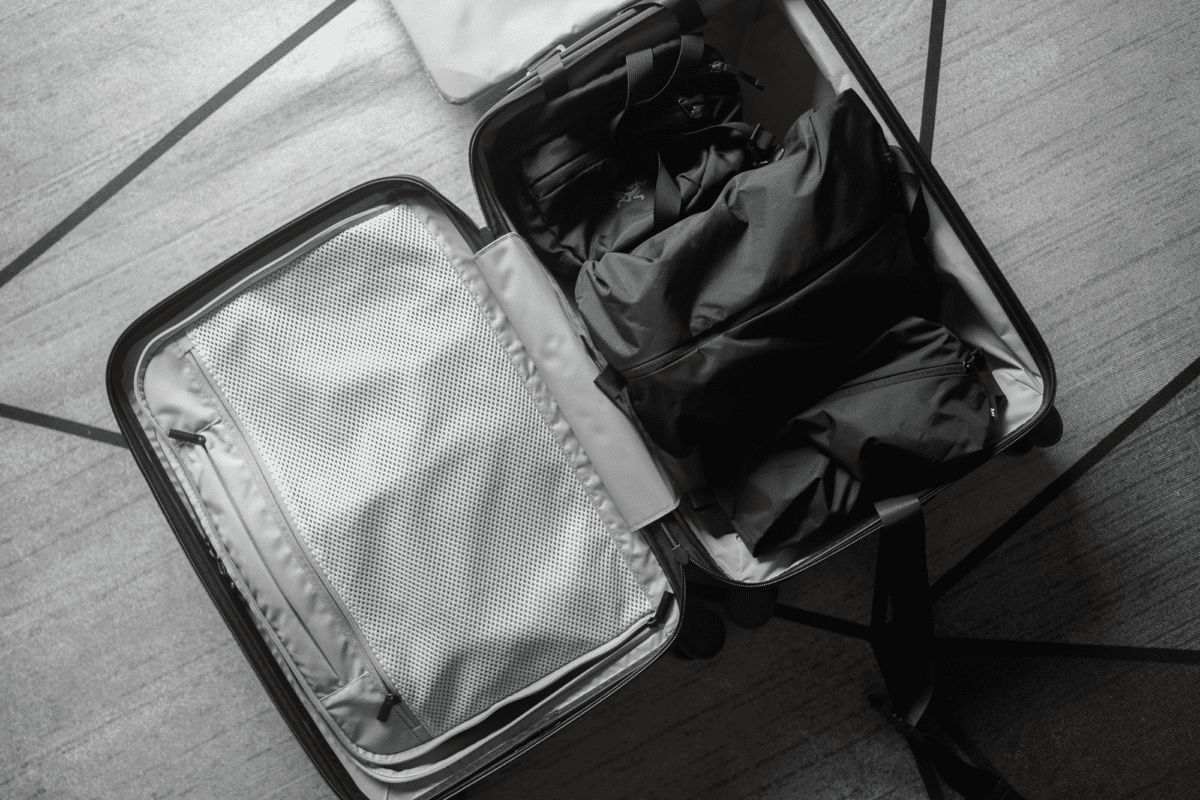
Slow travel means I stay in a single place for most of the trip. I just go through my usual routine but enjoy the newness of the environment. A single backpack is liberating when you are always on the move, but not so when you need the capacity for things to keep you comfortable. This is where a roller suitcase plays its part.
I have three roller suitcases, a Muji 75L that I've been using for the past 10 years, a 105L version of the same suitcase, and a Rimowa Original Cabin S that I got recently. The Muji ones are full-size check-in suitcases, so the more appropriate comparison would be the Rimowa even though the price point is different.
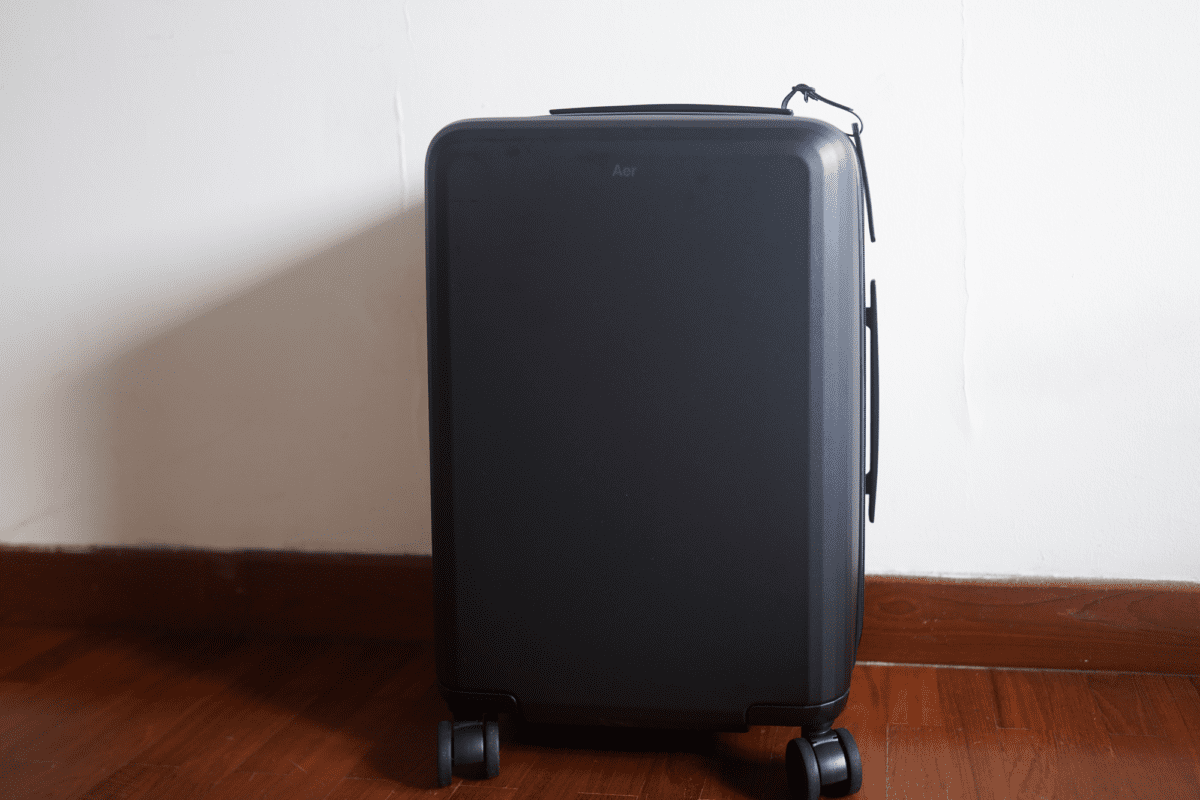
Style
I was surprised when I heard Aer produced a roller luggage. I assumed these hardcore backpack brands would never do roller luggage, since most of their fans are one-bag travel enthusiasts.
But I knew if they did do one, it would be beautiful like their backpacks. Aer remains the top of my list when it comes to aesthetics and the Carry-On is no different.
Unlike their mostly black-only bags, the Carry-On comes in five colors. However, hardware like the zippers and locks are in black for any other color, which makes the black one the only option that is consistently colored throughout.
Every single detail is not just black, but the same tone of black, which is pretty impressive to get right on different materials.
Unlike most suitcases that have rounded edges, the Aer Carry-On's edges have some kind of tiered effect. I am not sure if I like this detail but it sure is unique and I certainly don't hate it.

The only thing I thought could be improved aesthetically was the zipper. They probably decided on it because of the puncture-resistant feature, but it would look better if it was somehow seamless or hidden. Compared to how structured the surrounding form and materials look, I was wondering if there was anything smoother and more rigid that looked more “sealed” that could make it sleeker.
This used to be an ad.
But no one likes ads, so I got rid of them. If my articles helped you, I ask for your support so I can continue to provide unbiased reviews and recommendations. Every cent donated through Patreon will go into improving the quality of this site.
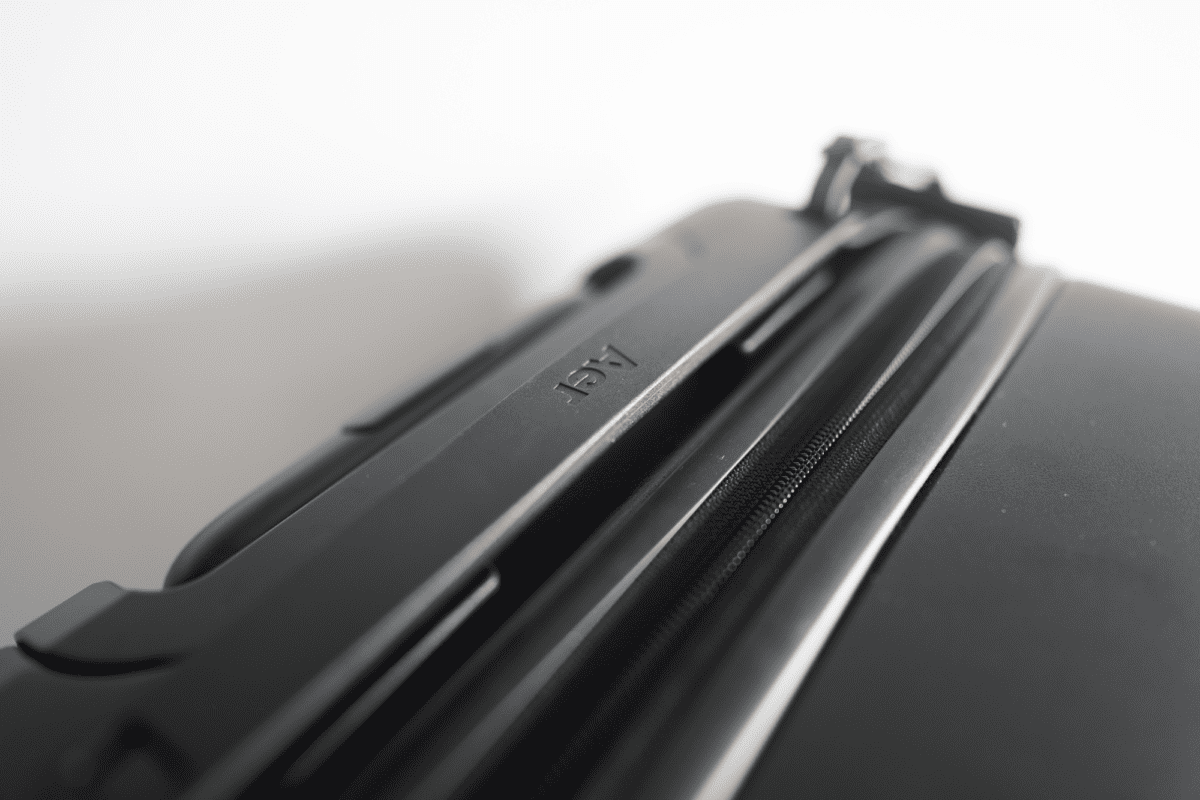
The texture of the outer material is quite rough. I've scrapped it onto different types of floors in my travels and it tends to pick up white residue. Unlike smooth surfaces where you can just wipe off easily, the sandy surface requires a bit of scrubbing to get through.

Material
I've reviewed just about every Aer product and they have consistently used only the best materials available, mostly ballistic nylon. Unlike the tried and tested material formulas on the backpacks, the luggage is a new area that calls for a little more analysis.
For hardcase exteriors, there are generally a few options for materials
- Acrylonitrile Butadiene Styrene (ABS)
- Polycarbonate (PC)
- ABS/PC Composite
- Polypropylene (PP)
- Polyethylene Terephthalate (PET)
- Aluminum
Polycarbornate (PC) is by far the most popular material for hardshell suitcases. It has flexibility, allowing it to withstand a certain level of bends, making is resistant to cracks.
While it is the heaviest of all the materials, the range of weight between materials is small (it is 12% heavier than the lightest one, polypropylene), making this difference negligible.
PC is slightly expensive because it is more durable. My 75L Muji suitcase has served me as my only suitcase for over 10 years and while I had to change the handle and wheel, the polycarbonate shell is still going strong.
Only aluminum is more durable, but unlike PC, it dents instead of cracks. Some might like this patina, but since aluminum is usually found in the mid-to-luxury range of cases, dents might put a dent in someone's heart.
The wheel uses the miraclent ball bearing from Japanese maker, HINOMOTO. It touts a low 44 db noise when rolling, compared to an average of 74 db from other brands. It is covered by Lisof tire from the same company, jointly developed with Mitsubitshi Chemical Corporation.
I designed a thing.

I found a 100 year old company that would create these heirloom quality canisters for me. They are handmade and will keep your tea leaves, coffee beans or anything that you need dry for years to come.
or read review
The zippers are puncture-resistant, double-layered YKK® RCW zippers (3x stronger than other luggage zippers).

You can insert a pen into the zipper of most luggage and open it without a lock. This saved me when I lost my luggage key once, but can be worrying for security. This is why some prefer paying the premium for Rimowa and its locking mechanism. However, these zippers are designed with a gapless slider design, specifically to prevent this which is unheard of on a luggage at this price range.
Usage
Size and weight
At 57cm x 38cm x 23cm, this is designed to fit into carry-on restrictions. Some budget airlines have a lower height limit, like Scoot Airlines (54 cm) or Jetstar (56 cm). But as long as your luggage doesn't look obviously oversized, I've never been asked to measure my carry-on luggage. The difference is going to be so minimal that even the most on-the-ball counter staff isn't going to bother.
The luggage weighs 8.4 lbs (3.8 kg), which can be a huge factor when weight limits are usually 15.4 lbs (7 kg). this means you can only carry another 7 lbs (3.2 kg) worth of items. This is approximately the weight of a laptop.
However, this is still lighter compared to something like the 49 L (1L more capacity than Aer) Rimowa Original Cabin Plus which weighs 10.4 lbs (4.7 kg).
This is probably the reason why I still prefer backpacks for carry-on. I will be mostly using this for my regular trips across the Causeway to Johor Bahru.
Wheel performance
One of the most critical features of a piece of luggage is the wheels. Bad wheels often get stuck or create an abnormal amount of noise when rolling.
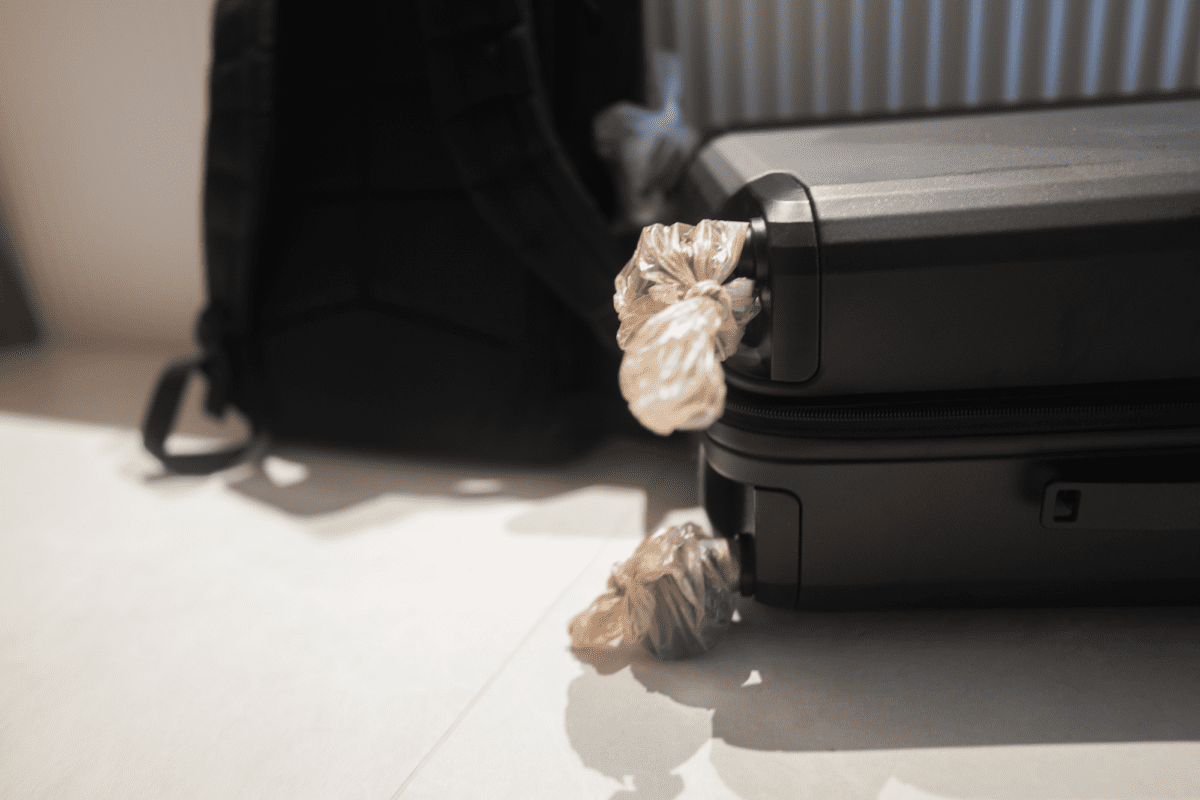
I've been spoilt by the smoothness of Rimowa's wheels, but Aer's wheels, while not as smooth or quiet as Rimowa's are better than most luggage I've tried.
Specifically, there is slightly more trembling and a little more resistance when changing directions. This difference can barely be felt and I had to roll them at the same time side by side to feel the difference, and even then, it is minor.
There is a switch to lock the wheels so they won't slide down on a slope. To engage, you need to push the switch to the end but to disengage, a flick of the switch will snap the switch back to the open position.
The switch is quite “loose” in place. If you look at it on a moving train, you’ll be able to see it trembling in place. Having it look more solid would add to the quality but this doesn’t affect the usage.
Locked wheels aren't a fool-proof way to keep your luggage from moving. My Aer Carry-On flew across the bus once when it came to a sudden halt. You still have to hold on to the handle.
Organization
Unlike backpacks, I have minimal expectation of organization in luggages. The amount and shape of things you pack can vary, and some organizations will get in the way. The only type of organization I expect is one that makes sure items stay on their side.
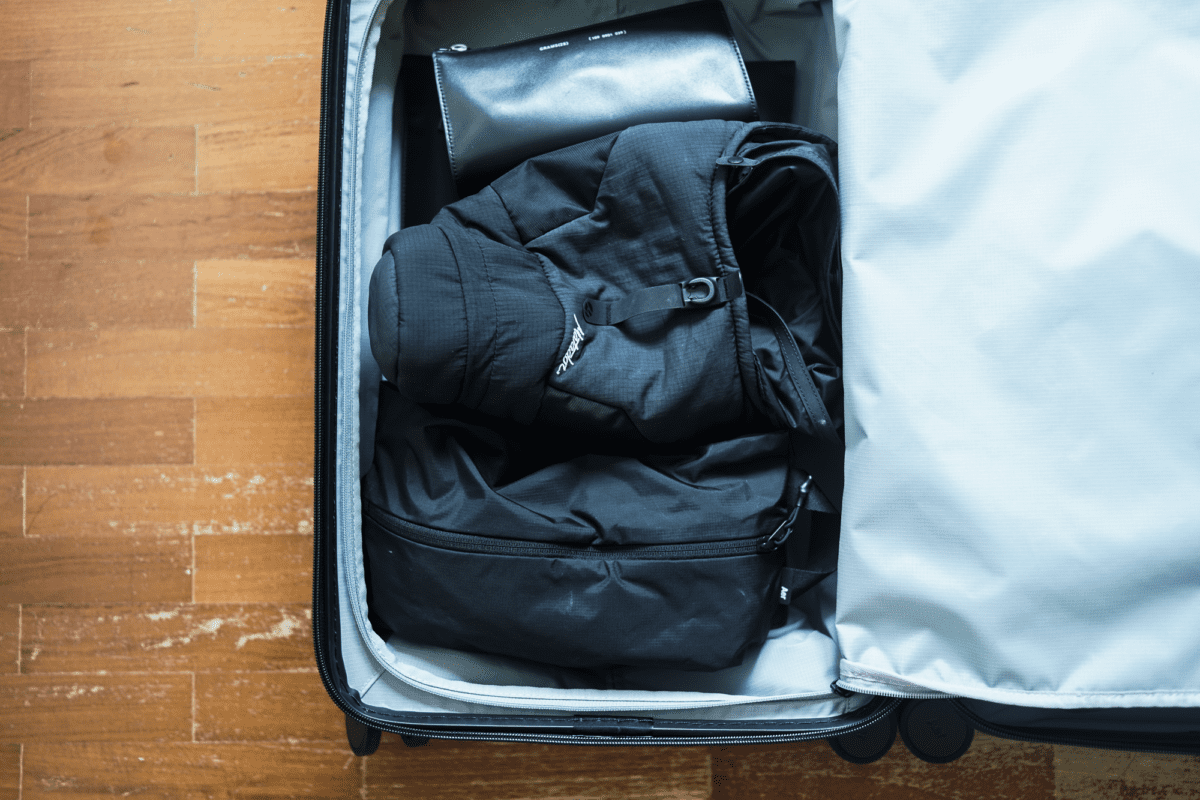
Luggage, like my Muji one, employs straps to do that. But this means you have to utilize packing cubes or only pack large items since straps won't prevent small items from falling out when you open them.
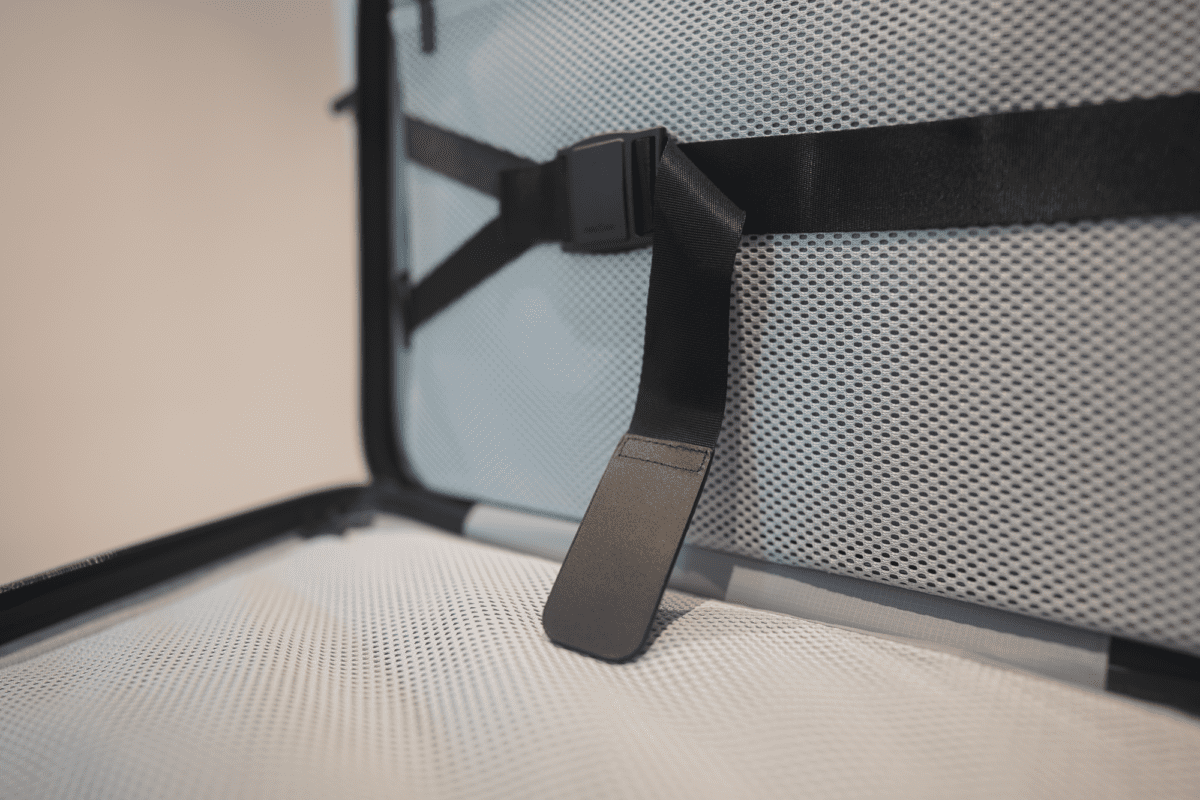
Aer’s has a zippered divider to hold down one side and a Rimowa-style compression system for the other side. This is much better than just a strap although small objects will still fall out the sides. You’ll need to take care in packing your larger items on this side. This will, however, give you more versatility to pack larger items.
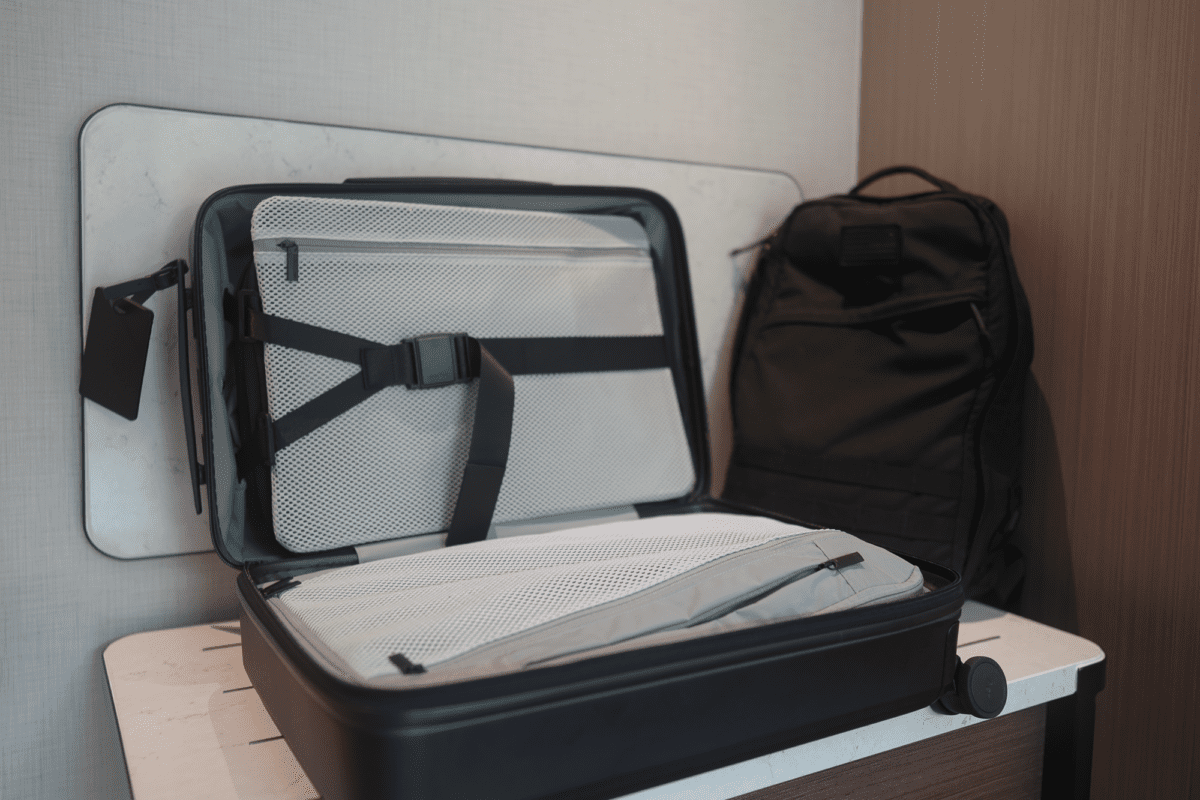
The compression sheet is non-removable and literally fabric wrapped around a plastic frame. The entire face is a pocket with a zipper that runs across. On the opposite side, there is the same, but slightly shorter, mesh pocket that runs across and a smaller zippered pocket above it.
Inside the smaller zippered pocket, there is a hidden pocket for your smart tracker. You don't want someone to find this easily in case it was stolen, and I am happy to say it took me five minutes of cross-checking with the product photos to locate it the first time.
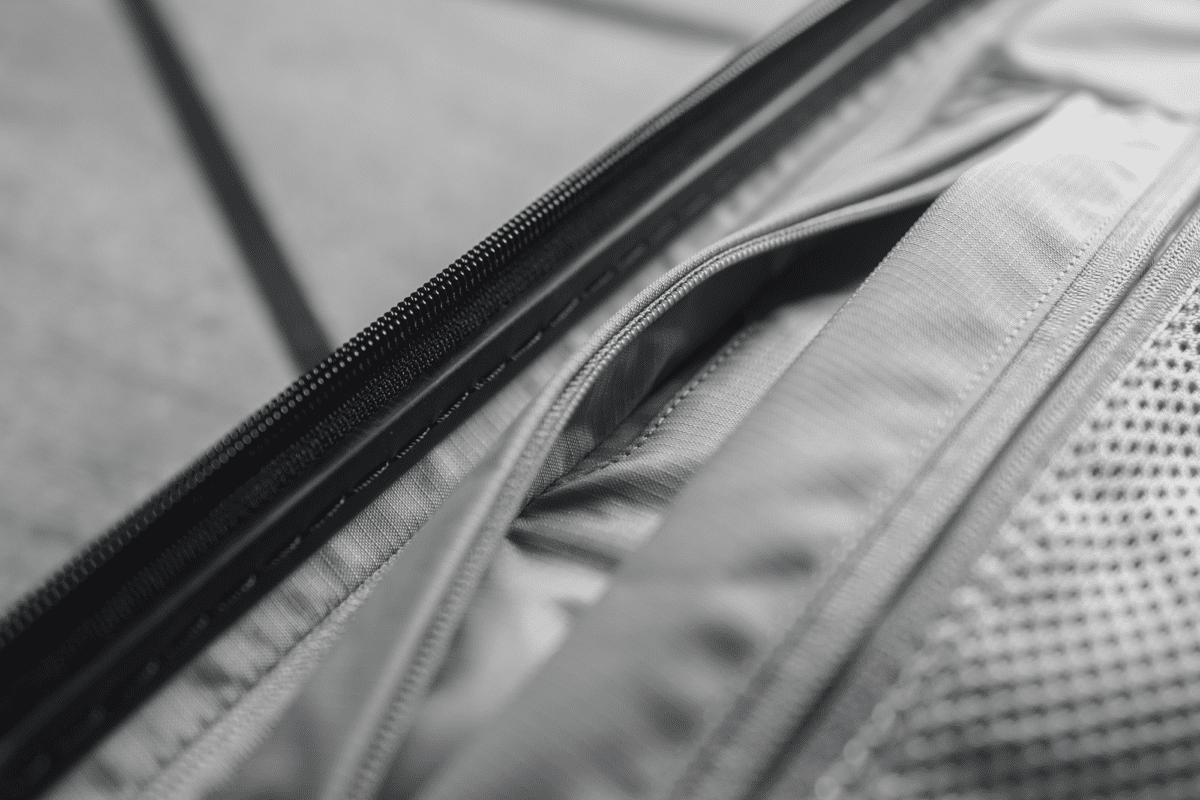
Security
While you might have your carry-on by your side when you are on the move, leaving it in hotels and hostels might expose it to some risks. I frequently use my luggage as a sort of locker in hostels and attach a Pacsafe Retractasafe cable lock to it.
The lock on the Aer Carry-On is TSA-approved. Some immigration security will break non-TSA locks to gain access or refuse your luggage altogether if they don't see the TSA red diamond logo on it. While it spoils the all-black colorway ever so slightly, I guess it can't be avoided.
I love how easy it is to set the lock combination, but at the same time, not intuitive enough for someone to try to overwrite your combination. Simply have the dials at 000 (the default), use a pen to push down the small reset button next to the dials, and set the new combination. Then, slide the main release button till the reset button pops back up, and you're set.
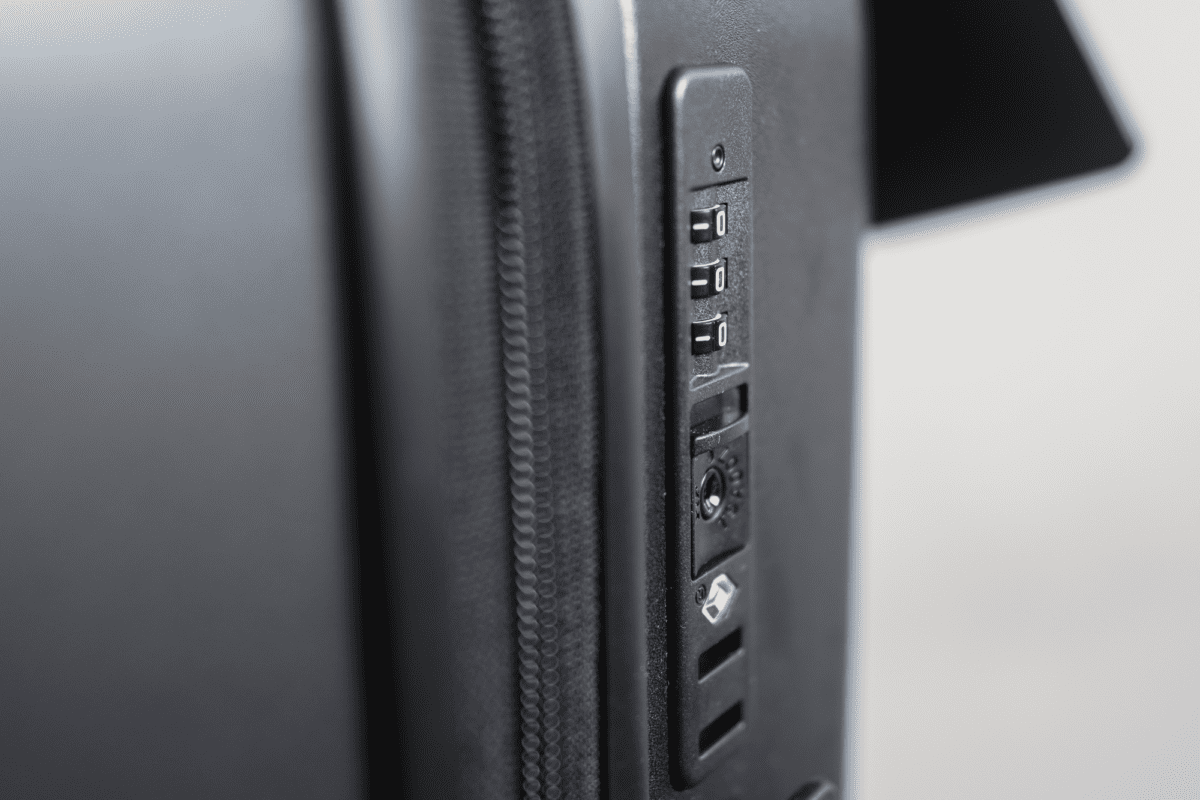
A common hack with zippered luggage is that you can break into any with a pen. You stab it through the zipper and it should open right up. The Aer Carry-On, however, uses one from YKK that specifically prevents you from breaking it open. I tried.
Handle
The handle has four height adjustment levels. Better luggage will have handles that you can adjust for any height. For example, the latest Muji ones let you adjust them at a 1 cm increment. Hopefully, Aer can support this in the next iteration.
The longest setting lets me grab the handle of a GORUCK GR1, that is resting on the Carry-On, and the Carry-On’s handle at the same time. This is a very comfortable height to hold at.
The handle felt a little wobbly to me. I had my luggage packed fully and when swiveling it using the handle, I could feel it torquing. Perhaps it is the material choice and could be unavoidable, but I have high expectations for Aer to solve this somehow.
Conclusion
Aer knocked it out of the park with the first version of the Carry-On Luggage. While there is some room for improvement like the sturdiness of the handle, the features and thoughtful details, like the puncture-proof zippers and AirTag pocket, are impressive.
Additional Images
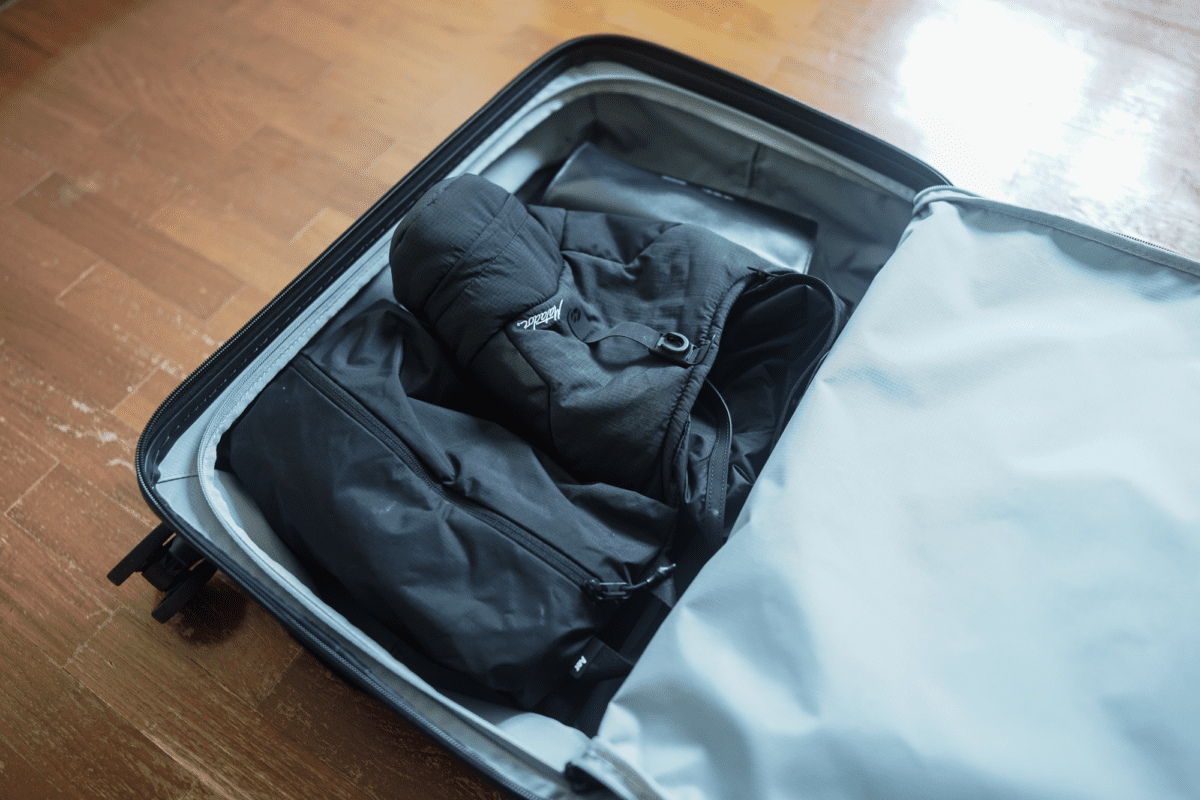
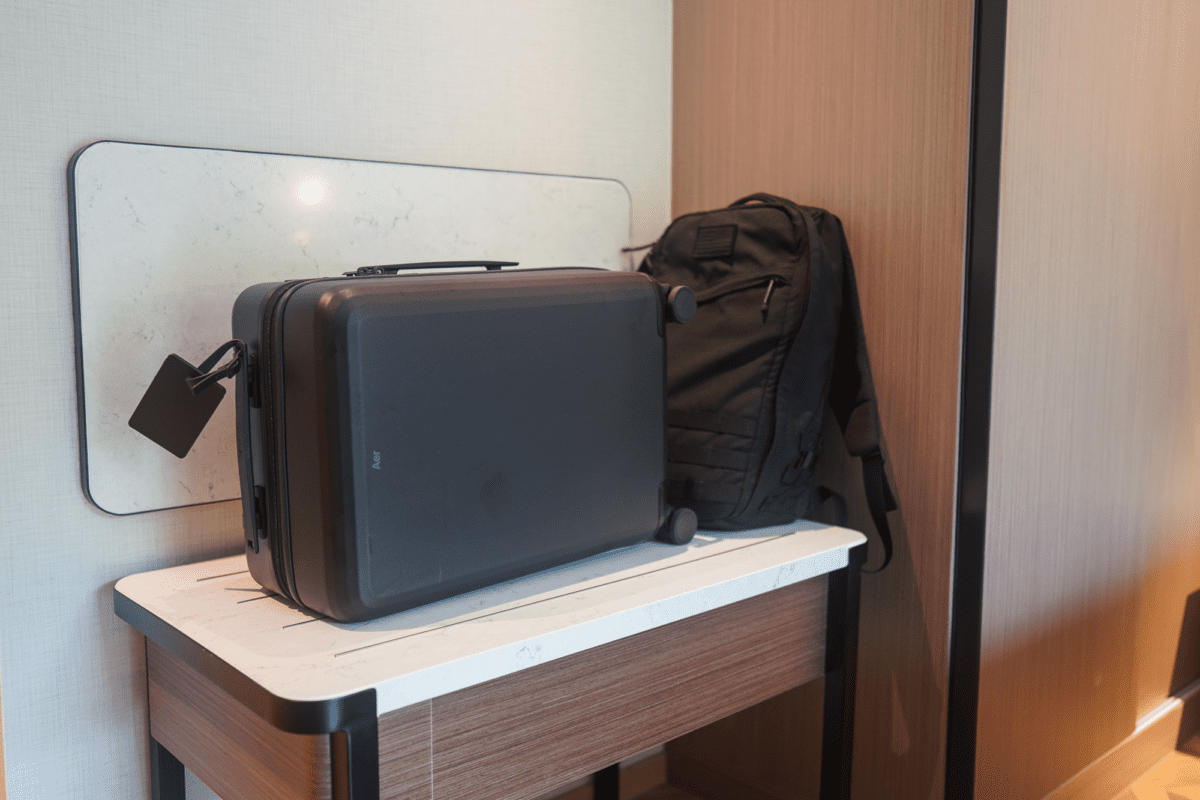
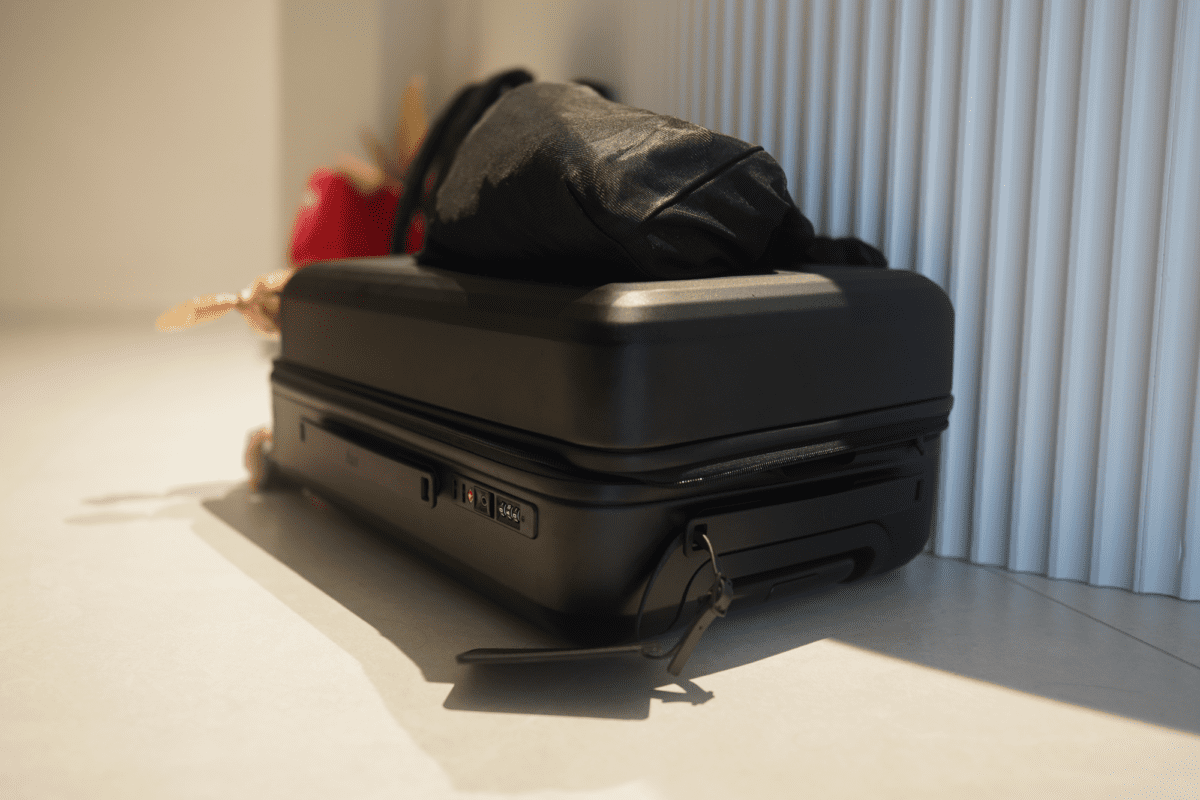
Like this review? See all of my in-depth reviews.
Also, consider supporting me by being a Patreon. Every cent given will go back into improving the content of this website.